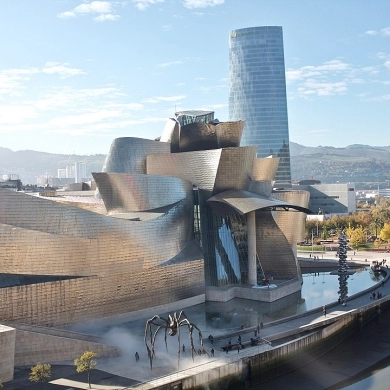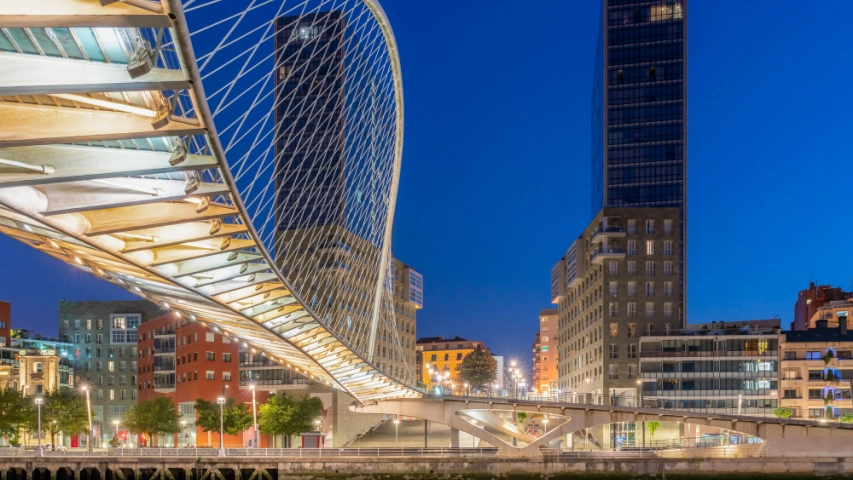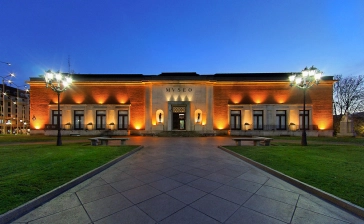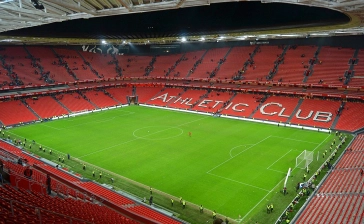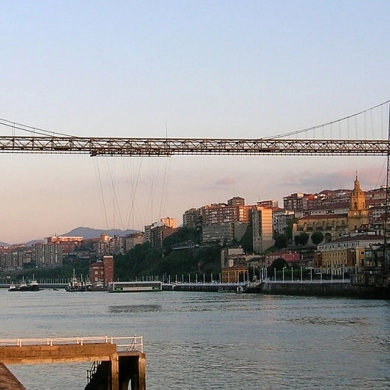Bilbao is a city with many accessible services and activities, making it a great destination for people with disabilities. Some of the top accessible attractions include the Athletic Museum, Guggenheim Museum Bilbao, the Carranza Valley, the Museum of Peace in Gernika, and the nearby town of Bakio where you can try the local Txakoli wine.
For those who enjoy nature, there is an accessible shepherd experience in Abadiño.
Additionally, there are many accessible beaches, excursions, theme parks, and restaurants in the city that cater to visitors with reduced mobility. It is recommended to check the website of Motion4rent for more information and offers for people with disabilities.
PLAZA CIRCULAR, 1 48001 Bilbao
- High Season (from April 9 to Sept. 18 and long weekends), Monday to Sunday: 9:00-19:30
- Low Season: Monday to Sunday: 9:30-17:30
- Open every day of the year
ALAMEDA MAZARREDO, 66 (Guggenheim Museum) 48009 Bilbao
- High Season (from April 9 to Sept. 18 and long weekends)
- Monday to Saturday: 10:00-19:00; Sunday: 10:00-15:00
- Low Season: Monday to Saturday: 11:00-19:00, Sunday: 11:00-15:00
www.bilbaoturismo.net/BilbaoTurismo/es/oficinas-de-turismo
Bilbao Airport:
The airport is fully accessible with ramps, elevators, and adapted toilets throughout the terminal. There are also designated parking spaces for people with disabilities located near the terminal building.
The airport also offers a shuttle service for passengers with reduced mobility, which can be requested in advance through the website or by contacting the airport's customer service.
Once you arrive at the airport, you can take a bus, train or taxi to reach the city center. There are several bus lines that connect the airport with the city center, including the Bizkaibus A3247 line, which runs every 20 minutes. The metro is also a good option, with the L1 line connecting the airport to the city center in just 30 minutes. Taxis are also available outside the terminal building, with a fixed rate to the city center.
Port of Bilbao:
The port also has adapted restrooms, elevators and ramps for easy access to the ships.
In addition to the ferries, the Port of Bilbao also offers cruises that depart from the city and take you to different destinations in the Bay of Biscay and the Atlantic Ocean. These cruises are also accessible for passengers with reduced mobility and have adapted cabins and facilities.
There are several ways to get to the port, including by bus, metro and by car. The port also offers parking for people with reduced mobility.
Overall, the Port of Bilbao is a great option for those who want to explore the city and its surroundings by sea, with all the necessary facilities and services to make the experience as comfortable and enjoyable as possible for everyone.
Train:
The station is fully accessible for people with reduced mobility with ramps, elevators, and accessible restrooms. There are also designated parking spaces for people with disabilities in the parking area of the station.
The metro, buses and trams in Bilbao are also fully accessible, with ramps and designated spaces for wheelchairs. The city also offers a free adapted transportation service for people with disabilities, called 'Bilbobus Adaptado'.
Metro Bilbao:
Signed by architect Norman Foster, it has become a symbol of the city for its accessibility, efficiency, impeccable design and its characteristic 'fosteritos', the entrances to the stations. Its three lines are not only the fastest way to move around the city, but also to access beaches and charming towns within the metropolitan area.
From the beginning, the stations, transit points, metro units, etc., were designed and built in such a way that they contained no physical barriers. In the design and construction of all the stations, we have taken into account not only the fact of not building architectural barriers, but also the installation of short and safe accesses for all the users.
Bus:
The Bilbobus fleet includes 28 low-floor buses that are fully accessible, with ramps and space for wheelchairs. The rest of the buses are equipped with a device to lower the bus's floor to curb level, making it easier for passengers with mobility issues to board and exit the bus. The Bilbobus also have a priority seating area for people with disabilities, which is clearly marked and located near the bus's door. Additionally, the buses are equipped with a visual and audio announcement system that indicates the next stop, making it easier for visually impaired passengers to navigate the bus route.
The Bilbao City View bus tour allows you to discover the city's main landmarks and attractions, such as the Guggenheim Museum Bilbao, the Old Town, the Basilica of Begoña, and the Estuary, among many others. It is a great way to get an overview of the city and plan your itinerary for the rest of your visit. Additionally, the buses are equipped with an audio guide that provides information about the sights and points of interest along the route. This is a great way to explore the city and learn about its history and culture.
Adapted taxi:
People with reduced mobility can request the service of an adapted cab. These vehicles provide the same service as any other cab, operate with a taximeter and apply the same fares as other cabs. To request an adapted cab, you can order it here:
https://www.taxibilbao.com/tipos-de-vehiculo/adaptado or https://teletaxibilbao.com/servicios/
The Casco Viejo is easily accessible for people with reduced mobility, as it is entirely on urban land. The route covers a distance of 1.6 km, with cobblestone pavement and some obstacles such as possible potholes and streetcar tracks. It is recommended to be cautious when crossing these areas. The neighborhood offers a variety of cultural and historical sites to visit, as well as a bustling market and plenty of shops and restaurants to explore. Overall, Casco Viejo is a must-see destination for anyone visiting Bilbao, with plenty of accessible options for people with reduced mobility.
Easily accessible route, it runs entirely on urban land. Distance of the section 1.60 km, cobblestone pavement, obstacles: possible potholes when walking on cobblestone pavement and streetcar tracks depending on where it crosses. Two sections have been differentiated:
- The first corresponds to an urban environment such as the Seven Streets of the Old Town. This route takes us without any type of difficulty to cross the seven main streets of the Old Helmet Bilbaíno. The surface is paved of marble, wide streets. When it rains it could become slippery.
- The second section runs through a recovered green area, recommended for people with reduced mobility. It begins at the Atxuri Train Station, taking us, with the estuary as a companion, to the Bilbao neighborhood of La Peña.
Pintxos, also known as Basque tapas, are small bite-sized snacks that are typically served on a skewer or toothpick. They are a staple in Basque cuisine and can be found in bars and restaurants throughout the region. They are often made with traditional ingredients such as fish, meat, and vegetables, and can range from simple to elaborate creations. Pintxos are often accompanied by a glass of wine or cider and are a great way to sample a variety of flavors and dishes in a casual setting. It's a great way to experience the local culinary culture and socialize with friends.
▪ The Mercado de la Ribera and its gastrobars.
▪ LEDESMA area (Abando/Moyúa metro station)
▪ DIPUTACION area, perpendicular to Gran Via (Moyúa metro station)
▪ Bocados del CASCO VIEJO, (Caso Viejo subway stop)
▪ Espacio GUGGENHEIM (Moyúa subway stop)
Timentality but also one of the main icons of modern Bilbao. The flowers that fill its stainless steel structure change with each season.
Puppy is a sculpture made of flowers and topiary, it's covered in thousands of live flowers and plants, which are carefully tended to by a team of gardeners. It is a unique and striking piece of art that adds to the vibrant atmosphere of the city. Visitors can walk around the sculpture and take pictures with it, making it a popular spot for tourists. Puppy is a great example of how Bilbao seamlessly combines contemporary art and nature to create an engaging and memorable experience for visitors.
- Mercado de la Ribera ( Ribera Market)
The market has a variety of stalls selling fresh produce such as fish, meat, fruit, and vegetables, as well as local cheeses and other delicacies. The market is fully accessible for visitors with reduced mobility, with ramps and elevators available. It is a great place to visit to experience the local culture and sample some of the delicious food that the region has to offer. It's open from Monday to Saturday, and it's closed on Sunday. You can check the opening hours on the official website of the market https://www.mercadodelaribera.com/ before your visit.
- AZKUNA ZENTROA, Alhóndiga Space
The Azkuna Zentroa, also known as the Alhóndiga Bilbao, is a cultural and sports center located in the heart of Bilbao. The building was originally a wine warehouse and was redesigned by the famous French designer Philippe Starck. The center offers a wide range of activities, such as exhibitions, concerts, workshops, and sports classes. It also has a rooftop terrace with great views of the city and a restaurant and bar. The center is fully accessible for people with reduced mobility, with ramps and elevators available throughout the building. It is a must-visit destination for anyone interested in art and culture, and is located in a convenient area with many shopping and dining options nearby.
The Arriaga Theater was built in the late 19th century, in 1888, and was named after the famous Basque composer, Crisanto Arriaga. The theater was designed by the architect Joaquín Rucoba in the neoclassical style, and it was considered one of the most modern and advanced theaters of its time. It has a capacity of more than 1,200 people and has hosted various performances, including operas, ballets, and plays.
The theater is fully accessible for people with reduced mobility, it has ramps and elevators to access all areas of the theater. Visitors can also enjoy guided tours of the theater, which are available in different languages and provide information about the history and architecture of the building, as well as its current use as a cultural center. The theater also has a shop and a café where you can relax and enjoy a drink before or after the performance.
- ENEKO BILBAO RESTAURANT, Avenida Abandoibarra, 4 48011 Bilbao, subway stop: San Mamés.
- VICTOR MONTES , Plaza Nueva 8, 48005 Bilbao, subway stop: Casco Viejo.
- RESTAURANTE BELTZ , Alameda Mazarredo, 61 48009 Bilbao, metro stop: Moyua
- MUGARRA , Ercilla, 14 48009 Bilbao, metro stop: Moyua
- BATZOKI BILBAO, Tendería 17, 48005 Bilbao, metro stop: Casco Viejo
